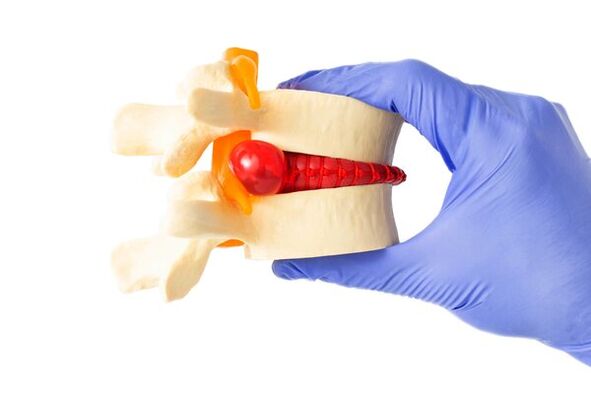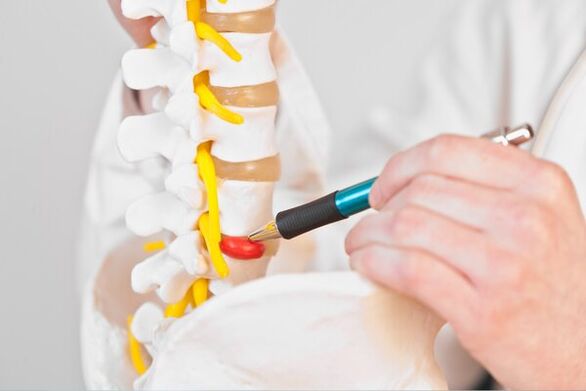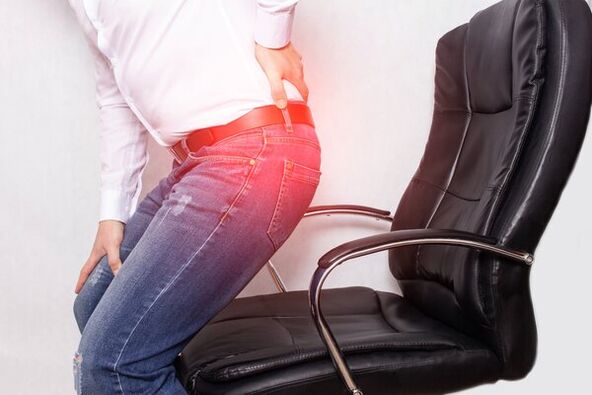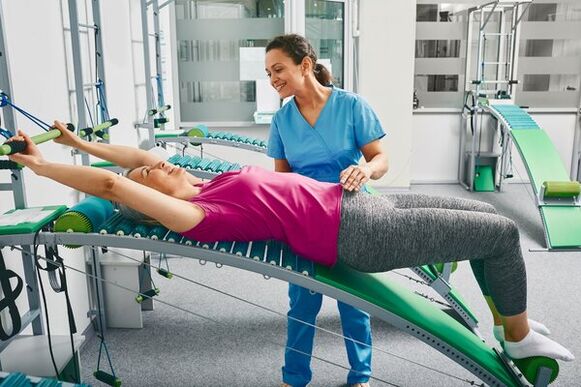Osteochondrosis is a widespread disease of the spine that affects the intervertebral discs and cartilage. The neck and lumbar regions are more sensitive to such processes. Osteochondrosis of the lumbar region can cause constant pain in the lower back and significantly complicate a person's life. In the treatment of the disease, conservative methods are preferred, surgical intervention is used only in extreme cases.
Causes of lumbar osteochondrosis

Osteochondrosis is not so much a disease as a natural phenomenon resulting from age-related degenerative changes of the spine. Normally, the disc in the lumbar spine acts as a shock absorber between two vertebrae and allows the joints and spine to move easily. The outer part of the disc, the annulus fibrosus, surrounds the soft inner core of the disc, the nucleus pulposus. Everyone's spinal discs undergo degenerative changes as they age, but not everyone develops symptoms.
Osteochondrosis is believed to begin with changes in the annulus fibrosus, intervertebral disc, and subchondral bone. The fibrous ring loses water, which makes it less able to withstand the daily loads of the spine, and is distributed incorrectly. Overloading the posterior part of the vertebra leads to arthritis of the facet joints and hypertrophy (growth, with the formation of osteophytes - bone growths) of the vertebral bodies next to the affected disc.
Reference! According to statistics, 30% of people between the ages of 30 and 50 have some degree of disc degeneration.
There are two main pathophysiological causes of pain in lumbar osteochondrosis. One possible cause of the pain is inflammation of the nerve as a result of the rupture of the outer part of the disc and the leakage of the inner core. Inflammatory proteins are released that irritate the nerve tissue.
According to the second reason, the vertebrae are no longer able to absorb the load effectively due to age-related deformation. This causes the spine to move abnormally and causes a painful spasm in the back muscles that try to stabilize the spine.
Osteochondrosis can result in the destruction of spinal segments, which can lead to radiculitis. Risk factors that trigger and accelerate the degenerative processes of the spine:
- Hereditary tendency to diseases of the locomotor system;
- Smoking;
- Previous injuries;
- Hormonal and vascular disorders;
- Excess body weight;
- Too weak muscles that do not provide the spine with the necessary support;
- Professional activities related to heavy physical work (athletes, loaders).
Stages of development of lumbar osteochondrosis

Disorders of the intervertebral discs, which lead to their degeneration and destruction, appear gradually. The entire pathological process goes through several stages, according to which the stages (or grades) of lumbar osteochondrosis are distinguished:
- The first stage (stage) is characterized by mild symptoms. Painful sensations develop against the background of irritation of the nerve endings by the nucleus pulposus and penetrate the fissures of the fibrous ring.
- The second stage is characterized by displacement of the upper vertebra compared to the lower one due to the cracking of the core and annulus. In addition to pain during movement, these pathological processes cause neurological symptoms, numbness and instability in the affected area.
- The third stage is characterized by an increase in pain and the appearance of an intervertebral disc herniation due to a violation of the integrity of the fibrous ring. Pain, sensory impairment and muscle weakness interfere with daily tasks. Due to the pinched nerve roots, the functioning of the urinary and intestinal systems can be disturbed.
- The fourth stage corresponds to the complete destruction of the intervertebral discs, they become fibrotic, and the osteochondral growths of the vertebral bodies in this stage cause immobility of the spine.
Symptoms of lumbar osteochondrosis
Get advice from experts to get started:
- A neurologist
- Orthopedic doctor
- therapist
The main symptom of lumbar and sacral osteochondrosis is pain. It is typically aggravated by prolonged sitting or turning, bending the spine or lifting a load. The pain may radiate to the legs and groin and may be accompanied by a feeling of numbness and weakness. Moderate, aching, dull pain may be followed by bouts of exacerbation.
The symptoms directly depend on the stage of development of the pathology:
- In the early period, when degenerative changes are just beginning to appear, symptoms are minimal.
- The intermediate stage, which is characterized by the weakening of the annulus fibrosus, can already manifest itself as lower back pain.
- In the later stage, when fibrosis develops in the structures and osteophytes are formed, the pain becomes less pronounced, but the mobility of the spine is significantly reduced.
The sensitivity of the lower back may increase when touched. Characteristic shooting pains and tingling sensations in the buttocks and thighs are a sign of pinching of nerve roots caused by degenerative changes in the disc. Patients with lumbar osteochondrosis have difficulty bending forward, backward and sideways. Osteochondrosis can complicate disc herniation and narrowing of the spinal canal, which is accompanied by the appearance of additional symptoms.
Diagnosis of lumbar osteochondrosis

Establishing a diagnosis begins with collecting the anamnesis, interviewing and examining the patient. The specialist will be interested in your complaints, physical activity, old injuries, bad habits and illnesses of close relatives. During the physical examination, the doctor palpates (feels) the lower part of the spine, looking for tender areas, inflammation, or any abnormalities. You can check the detection and perform motor tests.
The most popular method of diagnosing lumbar osteochondrosis is X-ray examination. The image will show the presence of osteophytes, the narrowing of the joint space of the disc, or the so-called "vacuum" symptom, when gas bubbles can be detected in the thickness of the disc. Other methods used are as follows:
- MRI, which shows hydration (the level of water saturation), the shape and height of the discs, which allows the identification of pinched nerves.
- CT scan, which allows for a detailed study of the state of the tissues and the diagnosis of abnormalities in the earliest stages.
- Provocative discography used to locate the affected disc.
Reference! MRI is a fairly accurate diagnostic method, but it cannot detect rupture of the outer rings of the disc.
Treatment methods of lumbar osteochondrosis
The preferred treatment for lumbar degenerative disc disease with chronic pain is conservative treatment with physical therapy, exercise, and medication. Recommended for patients with lumbar osteochondrosis:
- A daily routine that includes sufficient rest and adequate physical activity;
- Regular exercise to strengthen muscles;
- Lifestyle changes including nutritional review and weight loss.
Physiotherapy

Various physiotherapy techniques have been successfully used to reduce low back pain. Physiotherapy promotes the regeneration processes of the disc, stimulates metabolism and transport processes, prevents the formation of adhesions and further damage.
Physiotherapy methods used to treat osteochondrosis of the spine are as follows:
- Electrical stimulation. Electrical impulses help relieve back pain and improve blood circulation in the affected spine.
- Ultrasound therapy. Ultrasound waves can penetrate deep tissue layers and help relieve inflammation and pain.
- Magnetotherapy. Magnetic fields can improve blood circulation and metabolic processes in tissues, promoting their regeneration.
- Laser therapy. Laser beams can help relieve pain, stimulate blood circulation and stimulate tissue regeneration.
- Ultraphonophoresis. This method combines ultrasound therapy with the use of drugs that penetrate into the deep layers of tissue and help relieve inflammation and pain.
Important! Contrary to popular belief, osteochondrosis can and should be treated. Left untreated, it becomes a source of chronic pain and can lead to a number of problems, including disruption of internal organs.
Drug treatment
To relieve pain that interferes with daily activities, patients are prescribed pain relievers and non-steroidal anti-inflammatory drugs. According to the indications, the doctor may prescribe stronger drugs: muscle relaxants, steroids and narcotic pain relievers. Therapeutic blocks are given with local anesthetics and glucocorticoids to relieve intense pain.
Surgery
Surgical intervention is used much less often in osteochondrosis of the lumbar region. This may include disc arthroplasty or lumbar spinal fusion (creates conditions for two vertebrae to fuse together while reducing pain by eliminating movement of this part of the spine).
If the movement of the spine is significantly impaired, special intervertebral spacers can be installed. In patients who do not respond to all other treatments, a total lumbar disc replacement can be performed.
Treatment of lumbar osteochondrosis at home
The most effective thing you can do at home to maintain function and control pain is exercise. They increase the flow of blood, oxygen and nutrients to the spine, helping to keep the cartilage hydrated and the spine flexible for as long as possible. In addition, endorphins are released during exercise, which are natural pain relievers.
Frequent position changes also bring relief. Some poses help to cope with the attack of pain: kneeling, leaning, lying down. Short rest is necessary and beneficial, but prolonged bed rest only worsens the condition. It is important to stay active to prevent the disease from progressing. Patients with lumbar osteochondrosis benefit from walking, swimming, cycling, yoga, Pilates, stretching exercises and ligament strengthening. The following measures will also help:
- Heating the lower back improves blood circulation, relieves muscle spasms and tension.
- Ice packs help relieve pain and reduce inflammation.
- Massage also relaxes muscles, relieves spasms, and reduces pressure on the spine, thus relieving pain. By increasing the blood circulation in this area, the metabolic processes improve and the tissues are enriched with oxygen.
- Use of orthopedic mattresses and pillows. They help maintain the correct position of the spine during sleep.
- Correct distribution of the load on the spine. Proper lifting technique should be used when lifting heavy objects to avoid straining the lumbar spine.
- Proper nutrition. A balanced diet rich in calcium and vitamins helps maintain healthy bones and joints.
However, if you experience pain or other symptoms, before starting home treatment for osteochondrosis, consult your doctor to get more accurate recommendations and evaluate the condition of the spine.
Which doctor should I consult for lumbar osteochondrosis?
If symptoms characteristic of lumbar osteochondrosis appear, it is recommended to consult a neurologist or orthopedic doctor. If you have back pain, you can also make an appointment with a therapist. He prescribes the necessary tests to establish a diagnosis and refers him to a specialist.
Treatment of lumbar osteochondrosis
The specialists of the nearest clinic in the city or other settlement are ready to understand the reasons and help to cope with the pain. Doctors usually have extensive clinical experience and master all modern methods of treating and diagnosing osteochondrosis in women and men. For the most part, the convenient location, excellent equipment and versatility of the institutions are the priority of modern medicine, which allows you to quickly perform any examination and restore the health of the musculoskeletal system. You can book an appointment by calling the clinic that suits you and by filling out the online form on the website.
Prevention of lumbar osteochondrosis

Effective methods of preventing lumbar osteochondrosis include:
- Regular physical activity. Stay in good physical shape. Strengthen your back muscles. Back stretching and strengthening exercises help maintain spine health.
- Reduce stress on the spine: Avoid unnecessary stress on the spine. Proper lifting techniques must be used when lifting heavy objects.
- Posture correction: take care of the correct posture. Sit and stand straight, don't slouch. For sleeping, choose an orthopedic pillow and mattress to maintain the correct position of the spine even while resting. Buy quality shoes with good cushioning and support.
- Pay attention to the back support with orthopedic chairs if, due to the nature of your profession, you are forced to sit for long periods of time. Avoid staying in one position for long periods of time. Take regular breaks and stretch your spine.
- Watch your weight. Being overweight can put additional strain on the spine.
- Avoid uncontrolled movements and back injuries. Be careful during sports or physical activity.
- Stop smoking, which can negatively affect the health of your spine.
By following simple recommendations, you can live an active and full life, minimizing the risk of back pain. If you already have symptoms, pain in the lumbar spine, be sure to see a doctor for diagnosis and treatment.
























